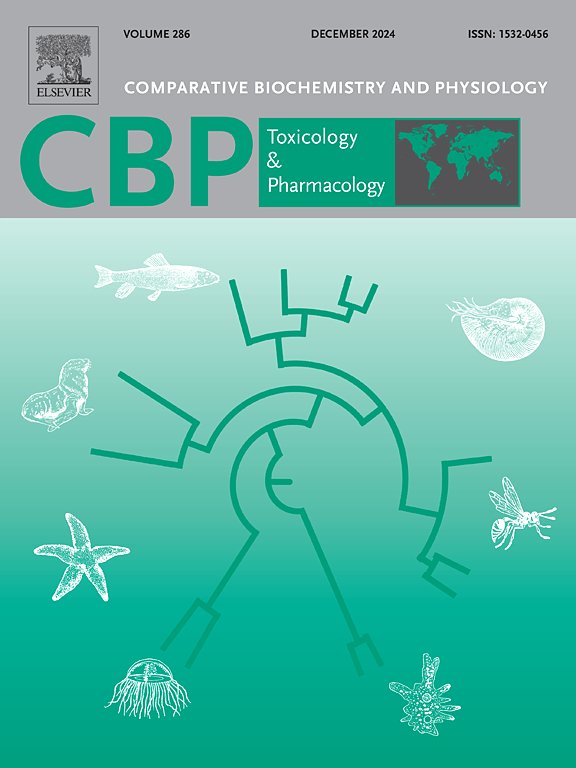Zearalenone delays tissue regeneration by dysregulating neutrophil balance in zebrafish (Danio rerio) larvae
IF 4.3
3区 环境科学与生态学
Q2 BIOCHEMISTRY & MOLECULAR BIOLOGY
Comparative Biochemistry and Physiology C-toxicology & Pharmacology
Pub Date : 2024-12-17
DOI:10.1016/j.cbpc.2024.110105
引用次数: 0
Abstract
Zearalenone (ZEA), a common mycotoxin, poses significant environmental and health risks. While its toxicological effects are well-studied, its impact on regeneration remains unclear. This study explored ZEA's effects on zebrafish (Danio rerio) larvae, focusing on developmental toxicity, immunotoxicity, and tissue regeneration. Embryos were exposed to 0, 0.5, 1, and 1.5 μM ZEA from 6 to 72 h post-fertilization (hpf). Although hatching and survival rates remained unaffected, malformations, including body axis bending and pericardial edema, increased dose-dependently, with 4.44 % abnormalities observed at 1.5 μM (p = 0.01). Heart rates also declined significantly at 1.5 μM (75.40 vs. 72.53 beats/30s, p = 0.0054). Immunotoxicity was assessed using Tg(mpx: eGFP) zebrafish to monitor neutrophil responses post-injury. ZEA exposure led to increased neutrophil counts (229.87 vs. 330.80, p < 0.0001) and chemotaxis (21.15 % vs. 34.57 %, p < 0.0001). RNA sequencing of 0 and 1.5 μM groups revealed disrupted redox balance and oxygen transport, with down-regulation of hbae1, hbbe2, and hbae3 and up-regulation of hif1a, indicating hypoxia involvement. Elevated reactive oxygen species (ROS), reduced antioxidant enzyme activity, and increased apoptosis were also observed.
Tail fin regeneration assays showed delayed regeneration at 1 and 1.5 μM ZEA, linked to impaired immune function and oxidative stress. These findings highlight ZEA's adverse effects on developmental and regenerative processes, underscoring its environmental and health implications and the need for further research.

玉米赤霉烯酮通过失调斑马鱼(Danio rerio)幼体中性粒细胞平衡而延迟组织再生。
玉米赤霉烯酮(ZEA)是一种常见的真菌毒素,具有重大的环境和健康风险。虽然它的毒理学效应已经得到了充分的研究,但它对再生的影响仍不清楚。本研究探讨了ZEA对斑马鱼(Danio rerio)幼虫的发育毒性、免疫毒性和组织再生的影响。胚胎在受精后6 ~ 72 h暴露于0、0.5、1和1.5 μM ZEA中。虽然孵化率和存活率未受影响,但畸形,包括体轴弯曲和心包水肿,呈剂量依赖性增加,在1.5 μM处观察到4.44 %的异常(p = 0.01)。在1.5 μM时,心率也显著下降(75.40 vs. 72.53 beats/30s, p = 0.0054)。免疫毒性评估采用Tg(mpx: eGFP)斑马鱼监测损伤后中性粒细胞反应。ZEA暴露导致中性粒细胞计数增加(229.87比330.80,p
本文章由计算机程序翻译,如有差异,请以英文原文为准。
求助全文
约1分钟内获得全文
求助全文
来源期刊
CiteScore
7.50
自引率
5.10%
发文量
206
审稿时长
30 days
期刊介绍:
Part C: Toxicology and Pharmacology. This journal is concerned with chemical and drug action at different levels of organization, biotransformation of xenobiotics, mechanisms of toxicity, including reactive oxygen species and carcinogenesis, endocrine disruptors, natural products chemistry, and signal transduction with a molecular approach to these fields.
文献相关原料
公司名称
产品信息
索莱宝
Reduced Glutathione (GSH)
索莱宝
Malondialdehyde (MDA)
索莱宝
Superoxide Dismutase (SOD)

 求助内容:
求助内容: 应助结果提醒方式:
应助结果提醒方式:


